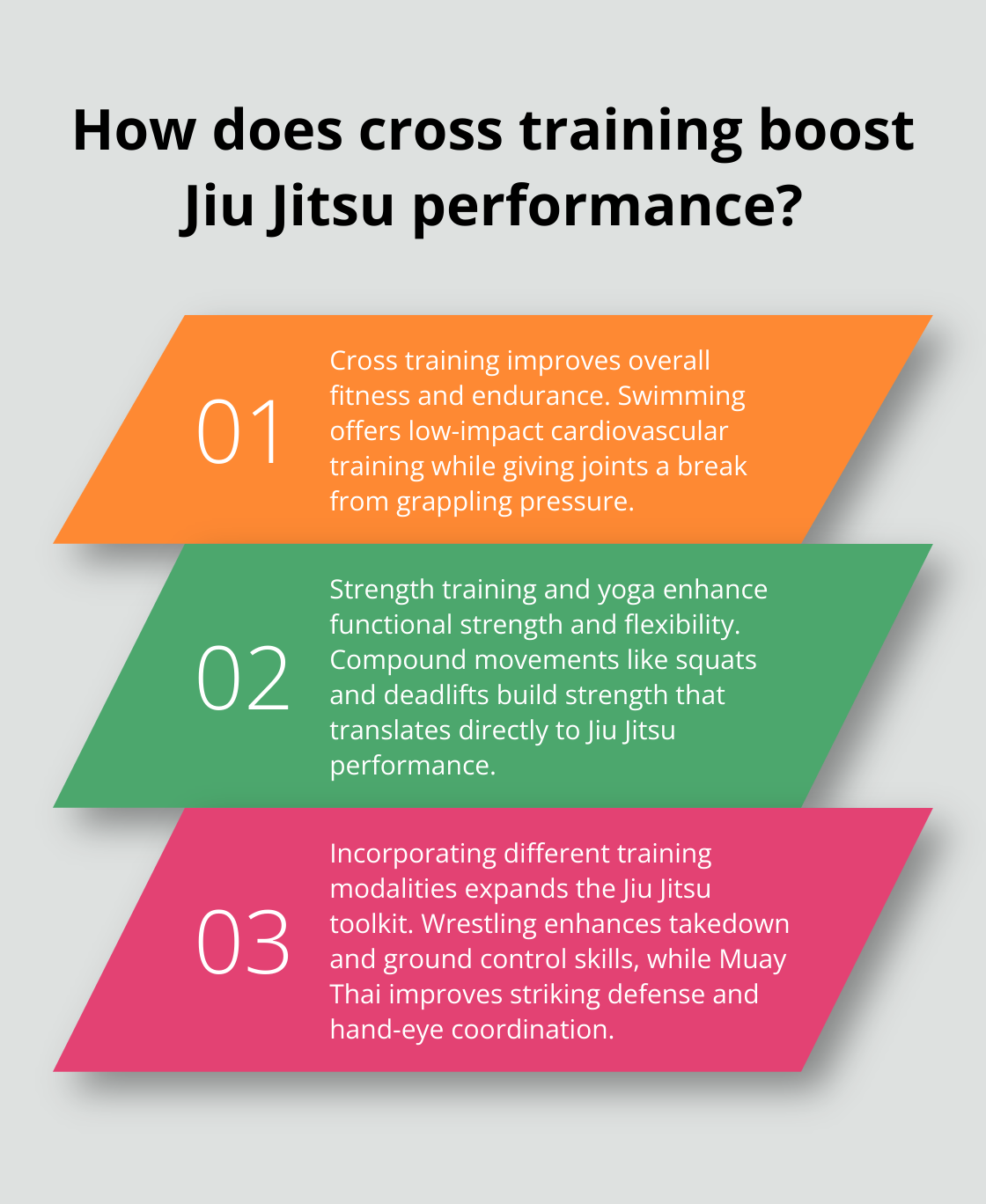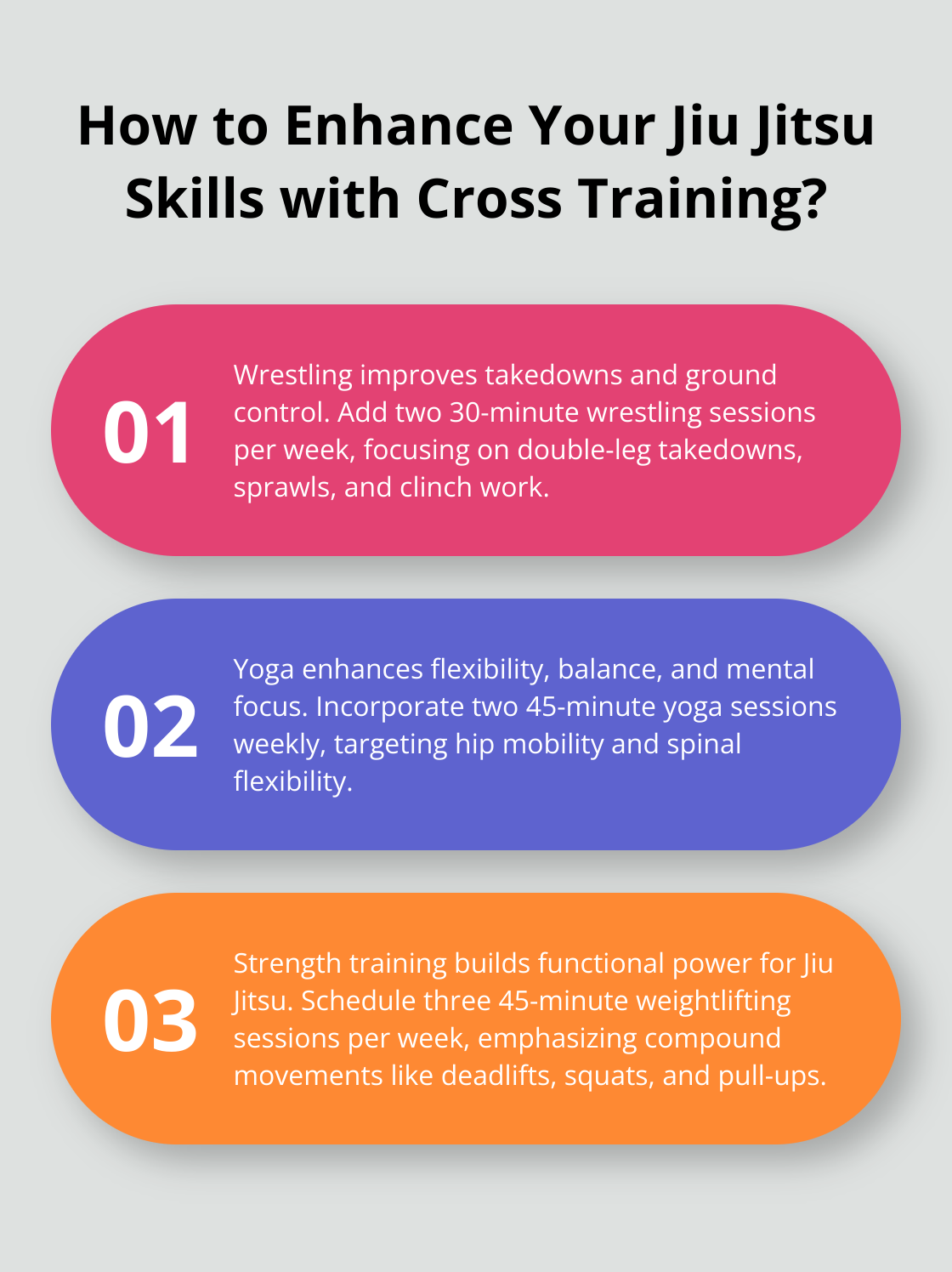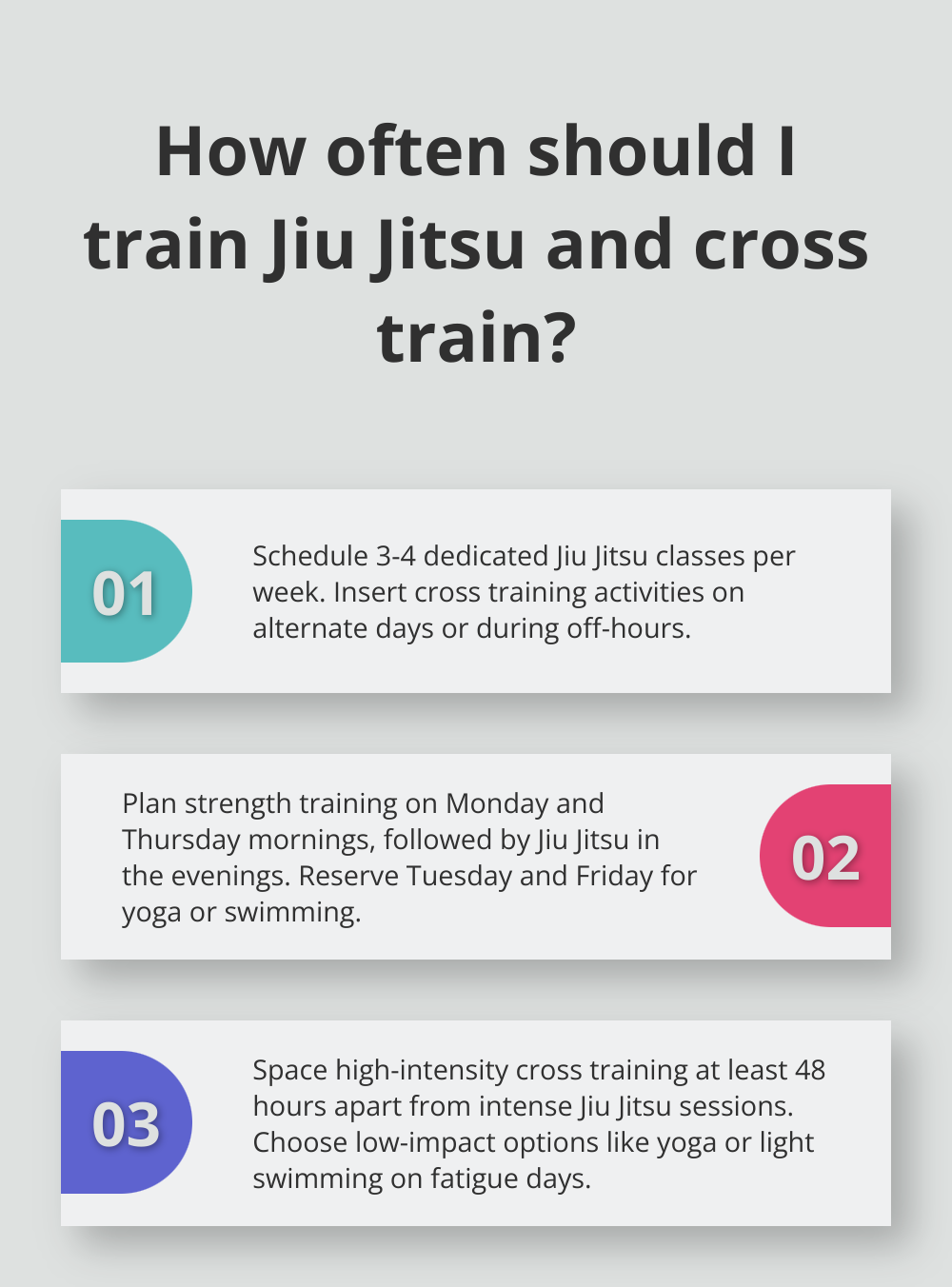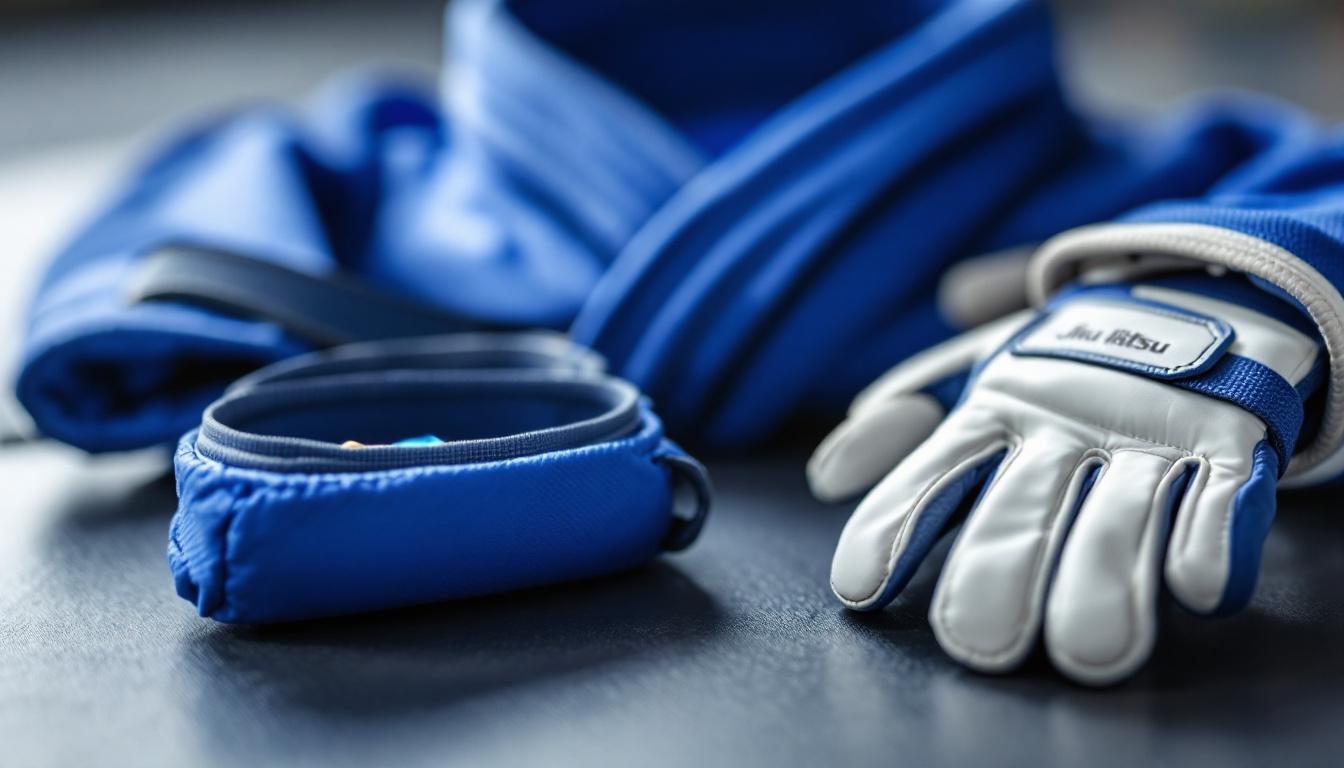At Jiu Jitsu, we know that mastering the art requires more than just time on the mats. Jiu Jitsu cross training has become an essential practice for practitioners looking to elevate their skills and overall performance.
By incorporating diverse training methods, you can enhance your strength, flexibility, and problem-solving abilities while reducing the risk of injuries. In this post, we’ll explore the benefits of cross training and provide practical tips to integrate it into your Jiu Jitsu journey.
Why Cross Training Boosts Jiu Jitsu Performance
Cross training revolutionizes Jiu Jitsu practice. It’s not about more mat time; it’s about smart, diverse training that enhances overall performance. Let’s explore how cross training can elevate your Jiu Jitsu game.
Supercharge Your Fitness
Cross training improves overall fitness and conditioning. This translates to more endurance during intense rolls.
Swimming offers a low-impact option that builds cardiovascular endurance. It maintains fitness while giving your joints a break from constant grappling pressure.
Build Functional Strength and Flexibility
Strength training isn’t just for aesthetics – it enhances performance. Compound movements like squats and deadlifts build functional strength that directly translates to Jiu Jitsu.

Flexibility plays an equally important role. Yoga dramatically improves range of motion. You’ll escape tight spots and apply submissions more easily.
Sharpen Your Mental Game
Cross training challenges your brain, improving problem-solving abilities on the mat.
Mental techniques like visualization and meditation (powerful tools in their own right) can improve focus and performance in high-stress situations, giving you an edge in competitions or intense sparring sessions.
Diversify Your Skill Set
Incorporating different training modalities expands your Jiu Jitsu toolkit. Wrestling, for example, enhances takedown and ground control skills. Muay Thai improves striking defense and hand-eye coordination. These complementary skills make you a more well-rounded practitioner.
Prevent Burnout and Injuries
Cross training prevents monotony and reduces the risk of overuse injuries. It allows different muscle groups to rest and recover while maintaining overall fitness.
Souza Grappling Co. understands the importance of a well-rounded training approach. Our facility offers not just Jiu-Jitsu, but also Muay Thai and Yoga classes, providing the perfect environment for effective cross training. With expert trainers and a supportive community, you’ll have all the resources you need to elevate your Jiu Jitsu game through diverse training methods.
Now that we’ve explored the benefits of cross training, let’s look at some popular options that complement Jiu Jitsu practice.
Top Cross Training Methods for Jiu Jitsu
Cross training transforms Jiu Jitsu practitioners. Let’s explore effective methods to enhance your skills and overall performance.
Wrestling: The Takedown Powerhouse
Wrestling complements Jiu Jitsu naturally. It improves your takedown game and ability to control opponents on the ground.
To add wrestling to your routine, focus on double-leg takedowns, sprawls, and clinch work. Try two 30-minute sessions per week, and increase intensity as you progress.
Yoga: Flexibility and Mental Fortitude
Yoga improves flexibility, balance, and mental focus.
Start with two 45-minute sessions per week. Focus on poses that target hip mobility and spinal flexibility. Add breathing exercises to enhance your mental game during intense rolls.
Strength Training: Building Functional Power
Weightlifting develops the strength and power needed in Jiu Jitsu.
Focus on compound movements (deadlifts, squats, and pull-ups). Try three 45-minute sessions per week. Adjust the weight and reps to align with your Jiu Jitsu goals.
Swimming: Low-Impact Cardio King
Swimming offers cardiovascular benefits without joint stress.
Add two 30-minute swimming sessions to your weekly routine. Mix up your strokes to target different muscle groups and improve overall conditioning.

Now that we’ve explored these effective cross-training methods, let’s discuss how to integrate them into your Jiu Jitsu routine for maximum benefit.
How to Seamlessly Blend Cross Training with Jiu Jitsu
Create a Balanced Weekly Schedule
Map out your weekly Jiu Jitsu sessions. Try to schedule 3-4 dedicated Jiu Jitsu classes as your foundation. Insert cross training activities on alternate days or during off-hours. Schedule strength training sessions on Monday and Thursday mornings, followed by Jiu Jitsu in the evenings. Reserve Tuesday and Friday for yoga or swimming, leaving weekends for open mat sessions or active recovery.
Tailor Intensity to Avoid Burnout
Monitor your energy levels closely. Schedule high-intensity cross training activities (like wrestling or HIIT) at least 48 hours apart from intense Jiu Jitsu sessions. On days when you feel fatigued, choose low-impact options like yoga or light swimming. Use a training log to track your perceived exertion levels after each session. If you consistently rate your fatigue above 7 out of 10, dial back the intensity or frequency of your cross training.
Track Progress and Adapt
Measure your progress in both Jiu Jitsu and cross training activities. Set specific, measurable goals for each discipline. For example, increase your deadlift by 10% over 8 weeks while simultaneously working towards a new belt promotion in Jiu Jitsu. Use performance metrics (submission success rates in sparring, flexibility improvements, or strength gains) to gauge your progress. Research published in the Journal of Strength and Conditioning Research found that progress among fitness parameters is interrelated, suggesting that improvements in one area may positively impact others.
Adjust Your Program
Modify your cross training program based on these metrics. If you notice improvements in your Jiu Jitsu performance correlating with certain cross training activities, consider increasing their frequency. Reevaluate exercises that seem to hinder your Jiu Jitsu progress.
Listen to Your Body
Pay attention to your body’s responses. The key to successful integration lies in flexibility and attentiveness. Balance different training modalities, adjust intensity, and track progress to create a synergistic relationship between your cross training efforts and Jiu Jitsu practice.

Final Thoughts
Cross training revolutionizes Jiu Jitsu practice, enhancing skills and overall performance. Diverse methods like wrestling, yoga, strength training, and swimming improve physical conditioning and sharpen mental acuity. Jiu Jitsu cross training provides practitioners with a competitive edge on the mats while reducing injury risks.

Creating a balanced schedule, adjusting intensity, and tracking progress lead to successful integration of cross training. Practitioners should explore different options to find their ideal combination. Listening to your body and adapting your approach as needed (when necessary) will maximize the benefits of cross training.
Souza Grappling Co. offers Jiu Jitsu, Muay Thai, and Yoga classes, providing an ideal environment for effective cross training. Our expert trainers and supportive community will help you elevate your Jiu Jitsu game through diverse training methods. Step off the mats and into new training territories to make your Jiu Jitsu journey more exciting and rewarding.




